Galapagos Odyssey - First Class Yacht

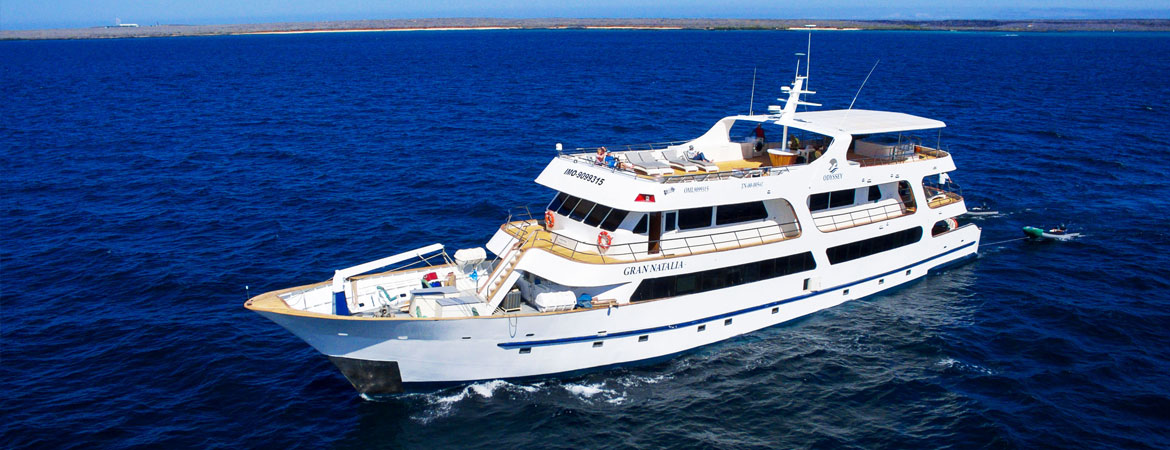

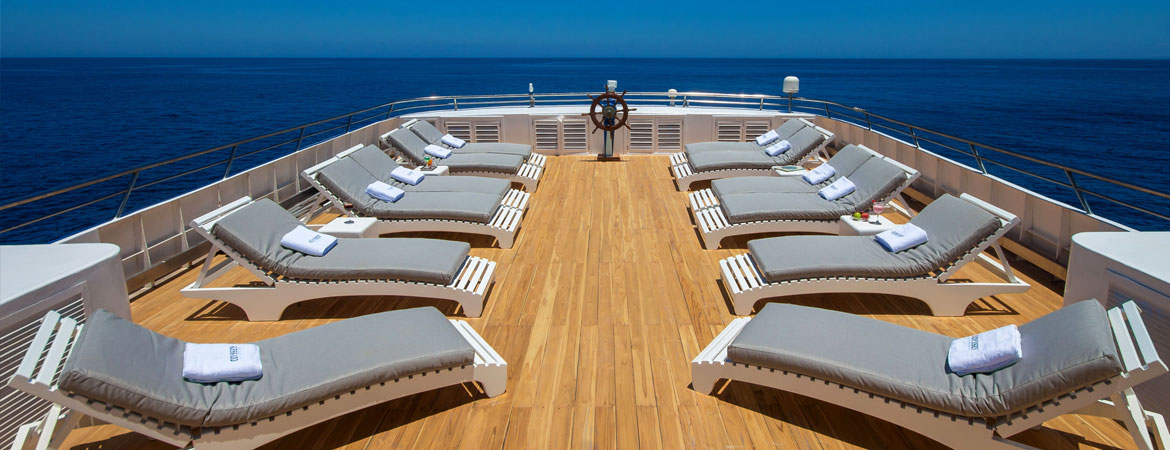
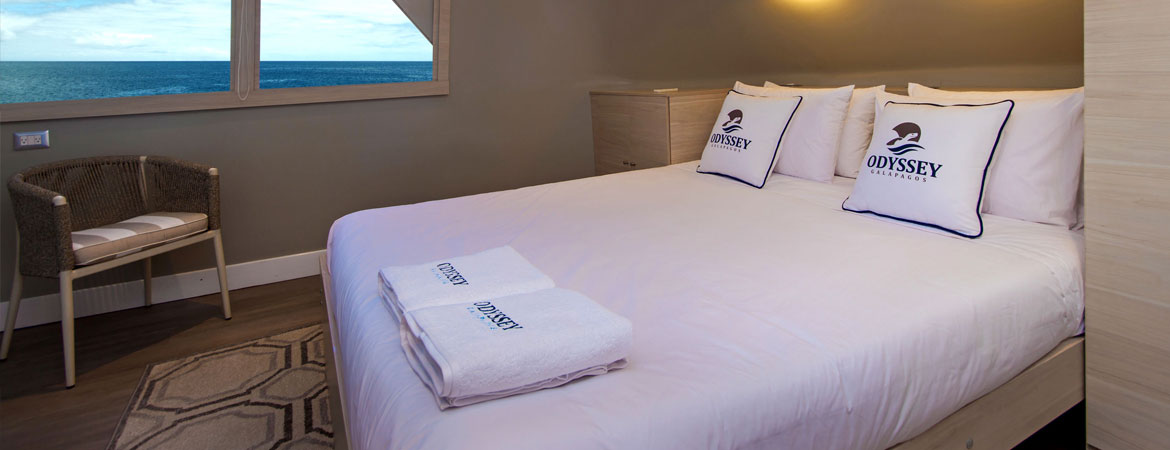


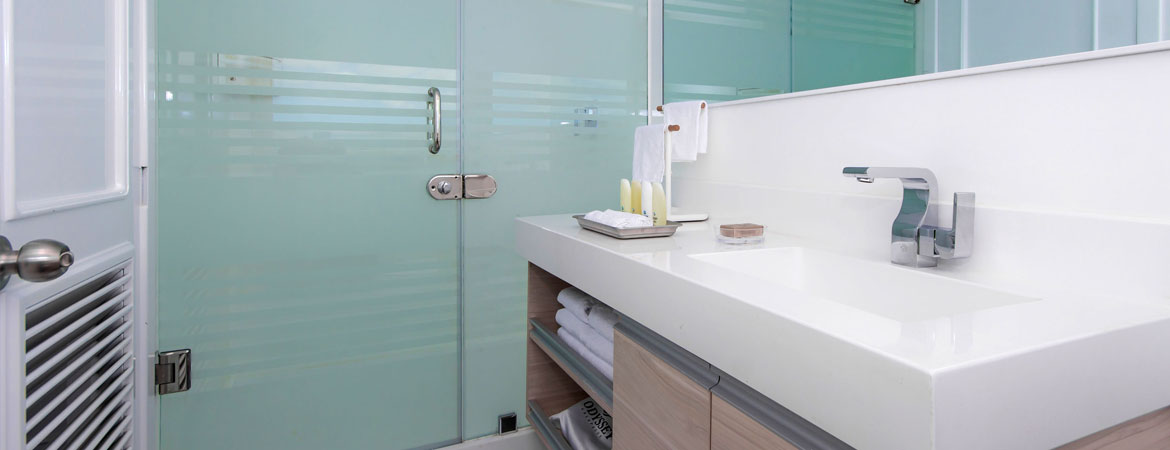
Galapagos Odyssey - First Class Yacht
The first class yacht Galapagos Odyssey has a capacity for 16 passenger in the Galapagos Islands that offers space, comfort and quality service. Amenities on board include a Jacuzzi, Al Fresco dining area, spacious sun and shade decks, combined with elegant interiors and a cabin layout that allows for picture windows that can be opened for fresh air flow. A great Galapagos Vacation itinerary includes the main wildlife highlights the Galapagos Islands have to offer. We include in our tours a variety of visitor sites such as volcano hikes, island trails, mangrove forests, turtle breeding farms, research centers, marine sites, and more. A cruise on board the Galapagos Odyssey will allow you to explore both land and marine fauna of the Galapagos archipelago. Activities you can enjoy are trekking, kayaking, snorkeling, and beachcombing amongst others.
With EQ TOURING you will be part of a unique wildlife exploration experience, it would be a great pleasure to have you on board as our guest.
Yacht Description
 The Galapagos odyssey was built to fulfill the highest expectations of any traveler seeking to experience the wonders of the Galapagos Islands in the most exclusive way. This first class yacht has been designed to reduce the impact on the very fragile Galapagos eco-system.
The Galapagos odyssey was built to fulfill the highest expectations of any traveler seeking to experience the wonders of the Galapagos Islands in the most exclusive way. This first class yacht has been designed to reduce the impact on the very fragile Galapagos eco-system.
All cabins feature individually controlled air-conditioning, a small desk, sofa, mini-bar, and closet, as well as spacious bathrooms with shower cabins. All main deck and upper deck cabins average 20 square meters in size including the bathroom. These cabins have big windows, which can be individually opened. Our Twin Cabins are spacious and fully equipped. It provides passengers with the comfort of a hotel room, while enjoying the constantly changing view outside their windows. Our matrimonial cabins are perfect for that romantic getaway, so you can enjoy the luxurious comfort with that special someone.
The Odyssey offers elegant and inviting social areas that are used to hold trip meetings, discuss your day to day itinerary, and share your experiences with other passengers.
Relax and enjoy the warm sun and the incredible Galapagos view on our comfortable loungers or in our Jacuzzi while zipping on one of our delicious cocktails.
Activities
On your vacation aboard the Galapagos Odyssey we want to offer you activities that will allow you to perceive Galapagos from different perspectives: guided hikes, snorkeling, swimming, optional diving, wildlife observation, and bird watching will give you the opportunity to experience the closest and most intimate encounters with this unique nature.
Snorkeling: This is a unique opportunity to experience the wonders of the Galapagos marine reserve like sea lions, sharks, turtles, penguins, and marine iguanas flopping around the water.
Hiking: Guided hikes will give you an amazing opportunity to get up close with nature. Moreover you will enjoy the truly spectacular landscapes of different geological formations. Wildlife Observation and Bird Watching
The encounter with the unique and fearless animals at very short distances is absolutely one of the most fascinating aspects of your visit to the Galapagos Archipelago. The Galapagos Islands are a real bird watcher's dream: 29 of the 58 resident bird species are endemic, such as the Darwin Finches, the Flightless Cormorant, and the Red footed Booby, among others.
DAY 1, THU, DEC 31
FLY TO GALAPAGOS ISLANDS AND BOARD THE M/Y GALAPAGOS ODYSSEY

AM: Be in time at Quito International Airport at 5:30 am for the Avianca Airlines flight #1632 departing Quito at 6:50 am and arriving to Seymour Airport in Baltra Island at 9:20 am. Transfer to your 16 passenger first class yacht M/Y GALAPAGOS ODYSSEY.
Begin your 4-night cruise through Darwin’s “Enchanted Islands”. Accommodations will be in double staterooms. All cabins are spacious and feature a private bath/shower and air-conditioning. All meals, lectures and shore excursions are included. The excursions and cultural programs are led by category “3” naturalist guides with years of experience in guiding in the Galapagos Islands.
On the outskirts of Puerto Ayora you will visit the shared area of the Charles Darwin Research Station (CDRS) and the headquarters of the Galapagos National Park Service. From here the indispensable conservation management and biological research of this unique archipelago and its surrounding waters are directed. This complex houses several interpretation and information centres about the National Park and the Galapagos Marine Reserve. The most memorable part of this visit will probably be the successful breeding centre and the enclosures with Galapagos giant tortoises.
DAY 2, FRI, JAN 1ST, 2020
CRUISING THE GALAPAGOS ISLANDS

AM: White Tipped Reef Shark Canal & Sierra Negra, Isabela Island
Just outside the harbour of Puerto Villamil on the largest island of Isabela, a group of islets protrude just above the ocean. These barely noticeable rocks form one of the most emblematic sites that you will visit during your cruise. The jagged black formations, dotted with mangrove and candelabra-cactus, are the remnants of a lava stream that has ended up in the ocean. While these are being demolished by the waves, and a collapsed lava tube forms a channel that fills-up on high tide, while the entrance is closed on low tide. Marine life gets trapped, including spectacular white tip reef sharks (called tintoreras in Spanish, as is the site’s official name).
Unlike the inviting beaches of Puerto Villamil, the tiny plagues on these rocky formations offer important and fully undisturbed breeding places for prehistoric-looking marine iguanas.
Sierra Negra is the 3rd highest volcano on Isabela and the 5th highest of the Galapagos (1124m / 3687ft.). It erupted a total of 7 times in the 20th century, the last time being in October 2005. It is the only major volcano on Isabela whose crater regions are actually open to tourism. A mysterious half-day hike through the cloud forests takes you to a viewpoint at the rim, offering fantastic views into the impressive caldera which is the largest of the archipelago. Since the discovery of so-called super volcanoes like Yellowstone it it is no longer listed as one of the largest craters in the world. A somewhat muddy trail to the rim will lead you through an unexpected, evergreen cloud forest that only exists in the highlands of the main islands.
PM: Wetlands, Isabela Island
The tempting white sand beach of Puerto Villamil is home to far more marine iguanas and Sally lightfoot crabs than bathing guests. Its overgrown beach wall hides the largest coastal lagoon of the Galapagos, attracting lots of aquatic bids and wintering shore birds; some come from arctic regions! It is part of a swampy coastal zone known as the wetlands, with an old mangrove forest, collapsed lava tubes, and even more salt and brackish ponds. These are home to the largest concentration and breeding site of American flamingos on the Galapagos, although we cannot guarantee that you will see these shy and nervous birds.
(B, L, D)
DAY 3, SAT, JAN 2
CRUISING THE GALAPAGOS ISLANDS

AM: Moreno Point, Isabela Island
Moreno Point tells you the intriguing story of how the famous lunatic lava fields of Sullivan Bay (Santiago) could develop in the future, when parts of the crust break and fall into the undermining lava tunnels. Pits and holes close to the coast would gradually fill-up with seawater. The once lifeless area would then become dotted with tidal pools and filtration lagoons, offering new opportunities to pioneer vegetation; finally the lava cacti would get company. Fringes of reed, sea grass and mangrove bushes surround the picturesque lagoons that have been transformed into lush oases. Your photos get the perfect finishing touch when the bright American flamingos and aquatic birds come to forage in the largest lagoon as well. In the wet season the fresh, promising greens become even more intense and contrast strongly with the dead, pitch-black lava.
PM: Elizabeth Bay, Isabela Island
Although there is no landing point, the marine visitor’s site of Elizabeth Bay offers two in one. You will undertake a long ride by inflatable dinghy that combines a visit to the Marielas Islets in the mouth of the bay, with the mangles in its innermost heart. In 1963 these highest mangles of Galapagos were close to complete destruction, when Volcán Chico, a parasitic cone of Sierra Negra, sent lava flows to this 20km (11mi) distant bay. Miraculously the flows came just a few kilometres back to a halt. The Marielas islets are an excellent place to spot marine iguanas and Galapagos penguins, which tend to stay in the front row at the base of the cliffs.
Next the inflatable dinghy will turn landwards, leaving the surf behind and enter the calm estuary of Elizabeth Bay through a rather narrow entrance. Whilst exploring the lagoons and shallow creeks, the outboard engine is turned off, so that you can enjoy the sounds of nature. Graceful Pacific green turtles swim slowly around you, sometimes popping their heads above the surface to breathe.
(B, L, D)
DAY 4, SUN, JAN 3
CRUISING THE GALAPAGOS ISLANDS
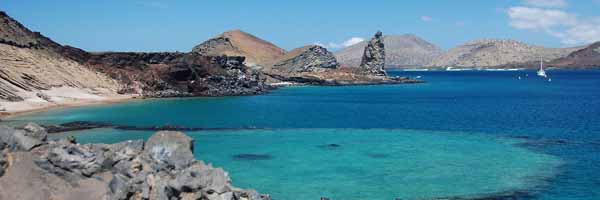
AM: Espinoza Point, Fernandina Island
Fernandina, located right above the Galapagos hotspot in the farthest west of the archipelago, is still under construction. It is estimated that between 60.000 and 400.000 years ago the top of this underwater shield volcano rose above sea level, which makes it the youngest of the main islands. Fernandina harbours one of the world’s most virgin, untouched ecosystems, and is therefore very well-protected. This exclusive and fascinating island will make you an eyewitness of evolution, which is happening right before your eyes! Espinoza Point is Fernandina’s only terrestrial visitor’s site, and one of the few locations where you will find some bizarre outgrowths of natural selection.
Besides the endemic wildlife, you will also love the almost unworldly views with the dominating cone of Volcán La Cumbre (‘the summit’ in Spanish) as a spectacular backdrop. The narrow headland that you walk along is the end of a lava tongue that has reached the
PM: Tagus Cove, Isabela Island
Right on the eastern shores of the Bolivar Channel are two tuff cones containing ultra-saline crater lakes: Tagus Cove and Beagle Crater. Both present spectacular layered cliffs at their sea faces, providing numerous nesting places for sea and coastal birds. From the inflatable dinghy you can observe marine iguanas, flightless cormorants, Galapagos penguins and storm petrels. It’s impressive to see flocks of blue-footed boobies and brown pelicans plunge diving from considerable altitudes. Explosive eruptions have blown out a part of the outer rims of both tuff cones, creating their characteristic horseshoe shapes. On one of these events the sea entered the caldera of the northern cone and formed Tagus Cove. The inner crater rim has remained intact and spared the region from an even more violent detonation when the seawater would have mixed up with the boiling volcanic materials. Nowadays it contains emerald Darwin Lake (though Darwin visited the neighbouring Crater Lake).
year).
(B, L, D)
DAY 5, MON, JAN 4
CRUISING THE GALAPAGOS ISLANDS
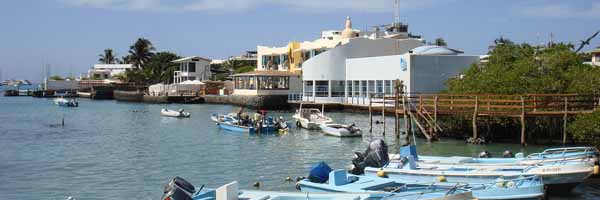
AM: Espumilla Beach, Santiago Island
Espumilla Beach is a visitor’s site at the northern end of James Bay, on the western coast of Santiago. This beach has been revived as an important breeding site for turtles, as it is no longer suffering from digging wild pigs. The turtles return year after year to bury their eggs in the cinnamon coloured sand dunes.The beach ridge hides a mangle with two picturesque lagoons on the backside. As often seen on the Galapagos, different vegetation zones are very close by, providing great scenic contrasts. Upon climbing a hill you will be rewarded with a beautiful view of the transitions from sea into beach into mangrove into dry palo santo forest.
PM: Egas Port, Santiago Island
Dominated by the 395m / 1300ft. high Pan de Azúcar (Sugarloaf), Puerto Egas is the southernmost pearl in the necklace of visitor’s sites along James Bay. It is named after Héctor Egas, who made a second attempt to mine salt commercially out of an inland crater lake in the 1960s. Santiago and its surrounding islets stand out due to their spectacular and unique volcanic and coastal landscapes, and Puerto Egas is no exception. The masterly sculptured coastline of black basalts, polished multi-coloured ash-layers, collapsed lava tunnels, natural arches, caves and blowholes such as ‘Darwin’s toilet’ and tidal pools form very photogenic scenery. If you are a wildlife lover, you will also fully enjoy this unique place that will probably become your favourite on this island. You will find lots of representative members of the Galapagos-population. Right below a spectacular rock arch in a grotto at the end of the beach, a colony of Galapagos fur seals has occupied the shade, sheltering from the equatorial sun. Unlike the more common Galapagos sea lion, these smaller species of seal are no beach-lovers, due to their adorable, but insulating coats. This outstanding refuge is the best place throughout the archipelago to see these endemic, shy and once heavily hunted marine mammals.
(B, L, D)
DAY 6, TUE, JAN 5
CRUISING THE GALAPAGOS ISLANDS

AM: Isla Lobos, San Cristobal
If your already know a bit of Spanish, you will not be surprised by what you will get to see at Lobos Islet… its beach harbours a colony of Galapagos sea lions. As in other colonies in the archipelago you can approach nurturing females within a few metres. In the breeding season this colony is also visited by very territorial males, defending and mating the harem on their part of the beach. Though at first sight the barren rocks are overgrown by palo santo, this low islet houses has more than just Galapagos sea lions. Two other emblematic species of the Galapagos also breed here. Male blue-footed boobies and great frigate birds try to impress the females (and tourists) with clumsy dances, heaving their striking blue feet or blowing up their balloon-sized scarlet pouches.
PM: Transfer to San Cristobal Island for your flight back to Guayaquil or Quito.
(B)
GROSS RATES |
|
|---|---|
| 6D/5N | |
| Double Main Deck Cabin | $4.945 |
| Double Suite | $6.181 |
Sun Deck
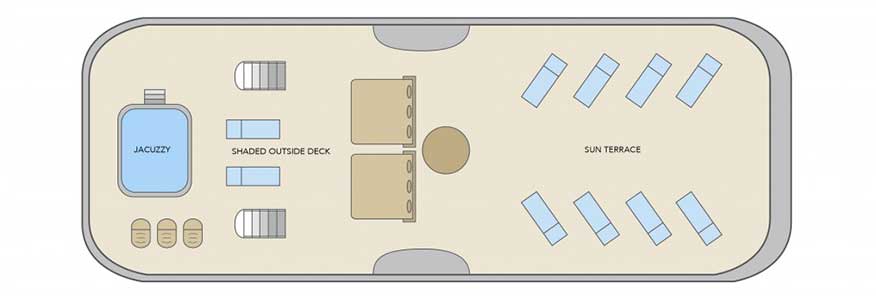
Upper Deck
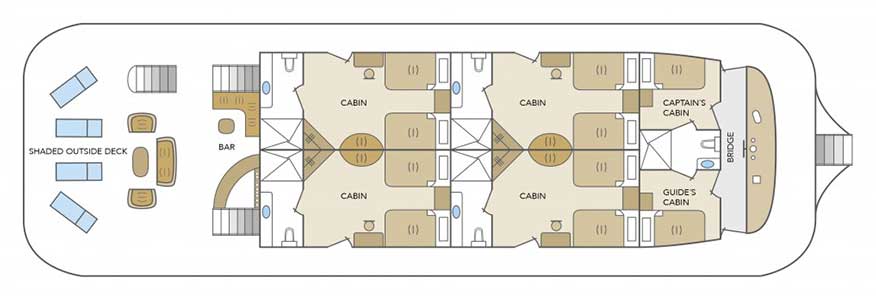
Main Deck
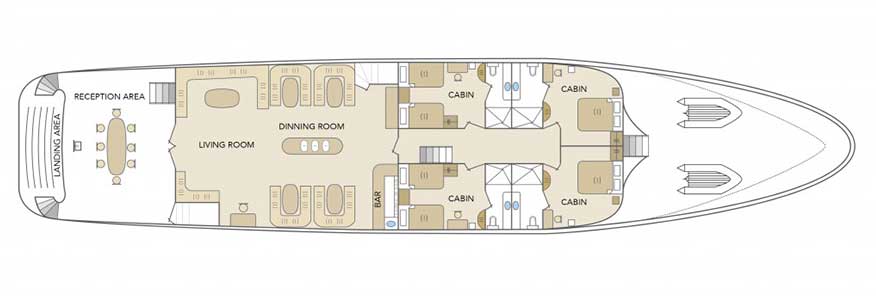
Lower Deck
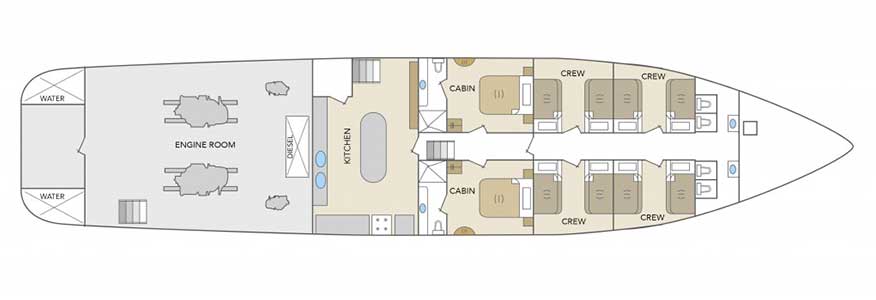
Specifications
| Length: |
|
| Speed: |
|
| Engines: |
|
| Generators: |
|
| Electric power: |
|
| Safety equipment: |
|
| Capacity: |
|
| Cabins: |
|
Inclusions:
Exclusions:
Important Observations
Contact Us
Sponsor Spotlight
M/Y Stella Maris
Galapagos luxury yacht charters, offering upscale cruises in a unique wildlife destination.
Exclusive Galapagos Cruises
Exclusive Galapagos Cruises
Machu Picchu Inc


